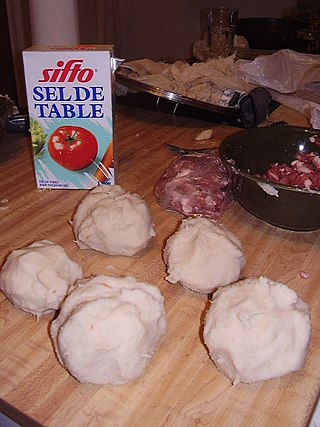
The Acadians are an ethnic group descended from the French who settled in the New France colony of Acadia during the 17th and 18th centuries.

Acadia was a colony of New France in northeastern North America which included parts of what are now the Maritime provinces, the Gaspé Peninsula and Maine to the Kennebec River.

Acadian French is a variety of French spoken by Acadians, mostly in the region of Acadia, Canada. Acadian French has 7 regional accents, including Chiac and Brayon.

Route 11 is a provincial highway in northeastern New Brunswick, Canada. The 440-kilometre (270 mi) road runs from Moncton to the Quebec border, near Campbellton, at the Matapédia Bridge, following the province's eastern and northern coastlines.

Memramcook, sometimes also spelled Memramcouke or Memramkouke, is a village in Westmorland County, New Brunswick, Canada. Located in south-eastern New Brunswick, the community is predominantly people of Acadian descent who speak the Chiac derivative of the French language. An agricultural village, it has a strong local patrimony, key to the history of the region. It was home to Mi'kmaqs for many years and was the arrival site of Acadians in 1700. A large part of these Acadians were deported in 1755, but the village itself survived.

The Acadian World Congress, or Le Congrès Mondial Acadien, is a festival of Acadian and Cajun culture and history, held every five years. It is also informally known as the Acadian Reunion. Its creator was André Boudreau (1945-2005).

Caisse populaire acadienne ltée, operating as UNI Financial Cooperation, is a Francophone credit union based in New Brunswick, Canada whose members are primarily Acadians. UNI's administrative headquarters are in Caraquet on the Acadian Peninsula.

The Acadians are the descendants of 17th and 18th century French settlers in parts of Acadia in the northeastern region of North America comprising what is now the Canadian Maritime Provinces of New Brunswick, Nova Scotia and Prince Edward Island, the Gaspé peninsula in eastern Québec, and the Kennebec River in southern Maine.

Phil Comeau is a Canadian film and television director, born in Saulnierville, Nova Scotia. He lives in Moncton, New Brunswick and Montreal, Quebec.
Festival international du cinéma francophone en Acadie, or FICFA, is a francophone international film festival held annually in Moncton, New Brunswick.

Caraquet is a town in Gloucester County, New Brunswick, Canada.

Acadian cuisine comprises the traditional dishes of the Acadian people. It is primarily seen in the present-day cultural region of Acadia.Note 1 Acadian cuisine has been influenced by the Deportation of the Acadians, proximity to the ocean, the Canadian winter, bad soil fertility, the cuisine of Quebec, American cuisine, and English cuisine, among other factors.
Françoise Enguehard a French-speaking author from Saint-Pierre-et-Miquelon who now resides in Canada. She served as president of the National Society of Acadia from 2006 to 2012 and is the current president of the National Acadian Foundation. She and her husband have been involved in promoting the history and education about Acadian people, through the development of schools. She speaks throughout the French-speaking countries to promote French culture. She received the rank of Knight in the Order of La Pléiade in 2011 and was honored as a knight in the Legion of Honour, France's highest award, in 2015 for her commitment to preserving the heritage of Acadians and Saint-Pierre-et-Miquelon.

Acadia is a North American cultural region in the Maritime provinces of Canada where approximately 300,000 French-speaking Acadians live. The region lacks clear or formal borders; it is usually considered to be the north and east of New Brunswick as well as a few isolated localities in Prince Edward Island and Nova Scotia. Some also include a few localities in Quebec and/or Maine.
Mathilda Blanchard was a Canadian labour leader. She was nicknamed la pasionaria acadienne due to her engagement and defense of Acadian workers in New Brunswick, particularly in the seafood trade.

Sainte-Anne-du-Bocage, or simply Le Bocage, is a Catholic sanctuary in Caraquet, New Brunswick (Canada).

Acadian architecture, also known as Cadien architecture, is a traditional style of architecture used by Acadians and Cajuns. It is prevalent in Acadia and, by extension, is employed for architectural purposes in the place.
Acadian theatre refers to theatrical productions that originate from or are perceived as originating from Acadia. The most prominent playwright is Antonine Maillet, whose play La Sagouine has been staged over two thousand times, with Viola Léger as the sole actress.

Melvin Gallant was a Canadian teacher, literary critic, editor and writer.
The Acadian culture has several characteristics that distinguish it from other regions of Canada.













